The odds of surviving a plane crash are higher than having someone convert on your banner ad.*
So forget display ads and say hello to inbound marketing.
What’s this?
Let’s just say it’s something that will help you turn your business into a lead-converting machine.
And you’re about to see how.
Plus—
We’ve included the best free resources that will get you up to speed along the way.
In this article, you’ll learn:
- What inbound marketing is
- How define inbound vs. outbound marketing
- Inbound methodology based on Hubspot’s flywheel
- 15 tactics to build a solid inbound marketing strategy
Learn how to improve your inbound marketing using AI-assisted customer service
And if this isn’t what you’re looking for, check out these:
- Best Lead Generation Tools
- Tricks to Generate Leads with Live Chat and Chatbots
- Lead Generation Strategy for Small Businesses
What is inbound marketing?
Let’s start with the inbound marketing definition—
Inbound marketing focuses on naturally inviting customers to get to know your product or service through a combination of such techniques as:
- Content marketing
- Social media marketing
- Search engine optimization
- Branding
With this approach to marketing, companies respond to how consumers behave online (the buyer’s journey). Inbound strategies aim to appeal to consumers’ emotions and interests and solve their problems.
Why?
To build trust with customers, get them to like your brand and know your offer. And ultimately, to convert.
In practice, inbound marketing means creating valuable content, making it visible in search engines, and circulating it on social media platforms. This increases the company’s exposure and generates word-of-mouth advertising.
Companies using modern marketing techniques want to be seen as market leaders in their field. To get this message across, they produce transparent, educational, entertaining, and relevant content.
Pull marketing (as inbound marketing is often referred to) isn’t about selling products or services but selling ideas and the brand’s point of view.
When the business starts generating qualified leads for the sales team to follow up on, you know your inbound marketing works. Measuring the effectiveness of inbound strategies is straightforward and quantifiable. Digitalization makes it possible to gather complex data, analyze and even visualize it—from return on investment (ROI) to customer acquisition cost (CAC) and customer lifetime value (CLV) to other key metrics.
The success of inbound methods depends on its holistic approach. It requires teams to collaborate closely together to develop engaging content, distribute it on all channels, and continuously measure the results.
Inbound vs. outbound marketing—what’s it all about?
Traditional outbound marketing strategies aim to spread the message to a broad audience to grab their attention. They rely on mass communication tools, such as:
- TV commercials
- Radio ads
- Print advertising
- Cold calls
- Direct email
- Billboards
- Event sponsorship
- Trade shows
But you can find outbound techniques in digital distribution channels, too, particularly:
- Display ads
- PPC campaigns
- Spam
Marketers call those techniques traditional, interruptive, or push. And it pretty much sums up what outbound marketing is.
With outbound marketing, you have to repeat the message to be heard and it reaches people who aren’t your target, too. Despite that, traditional advertising did work for a while. But outbound techniques became worn-out.
People exposed to them nowadays don’t pay attention, or worse, feel harassed and suspicious of brands’ intentions. In fact, as of September 30, 2020, 241 million people chose not to receive telemarketing calls and registered their numbers on the national Do Not Call Registry.
The goal of all marketing activities remains the same over time—promote products and services to acquire leads and ramp up sales. But since digitization changed the way people learn about new products and services, a new term was needed to describe the paradigm shift in marketing.
In short, what worked a few decades ago, doesn’t necessarily work now. Today, there’s no longer a need to fight for advertising space.
Instead, you must fight for attention.
And the way you do it can have an impact on consumers’ decisions.
Here’s a quick overview of the key differences between the two types of marketing.
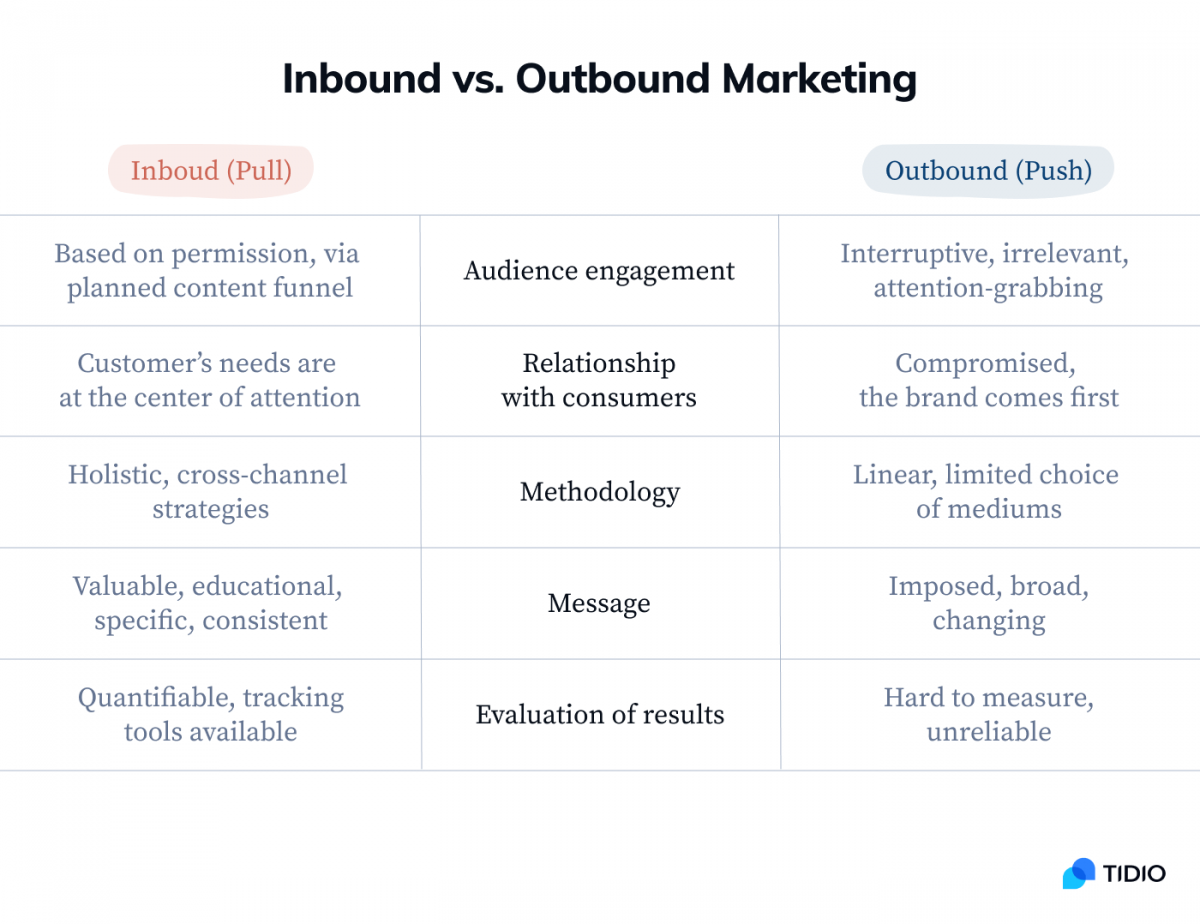
What are the stages in the inbound methodology?
The inbound methodology consists of four essential stages: attract, convert, close, and delight. The stages are based on the most common path consumers follow when deciding to buy a product or service and draw them to your brand.
HubSpot came up with a clever way to conceptualize how your marketing efforts affect the customers and your company’s growth. It became known as Hubspot’s flywheel. Other names include the inbound flow chart or marketing funnel.
Whatever the name, inbound always starts with attracting the right visitors who you can then convert into leads, close (sell to), and finally delight.
Pro Tip: You can take a Hubspot inbound marketing certification course to learn the fundamentals of inbound marketing.
Let’s go over every stage of the inbound marketing funnel before we look at specific inbound strategies that can be used at each of them.
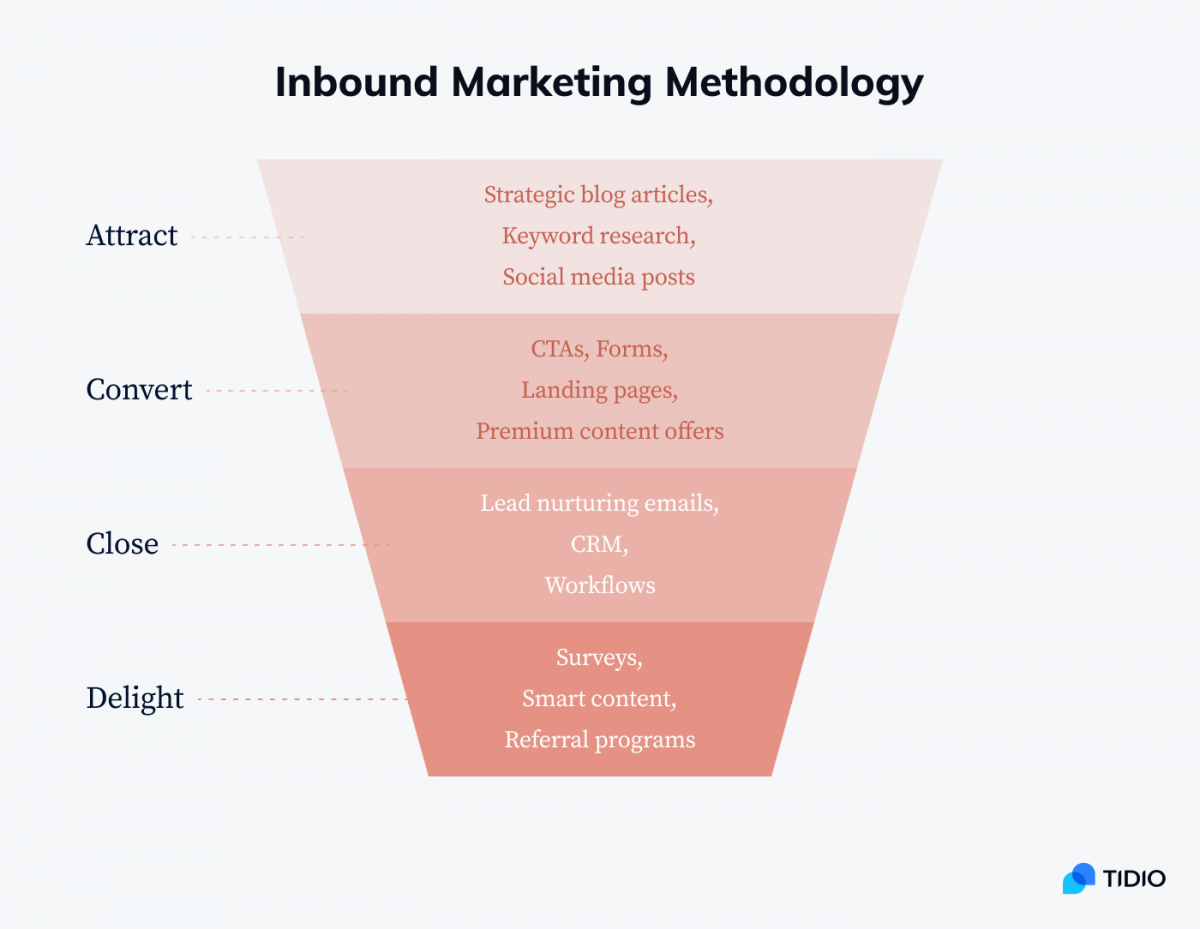
1. Attract visitors to your website
First, let potential customers know about your products and services’ existence—but don’t attract random people and don’t do it in a loud or spammy way. Target those who are most interested in your offer. You can attract them through your website, a blog, SEO strategy, or social media channels, like Facebook or LinkedIn.
How?
Solve their common issues and answer their questions. Become their trusted advisor without force-feeding them your promo materials. This way they’ll want to engage with you.
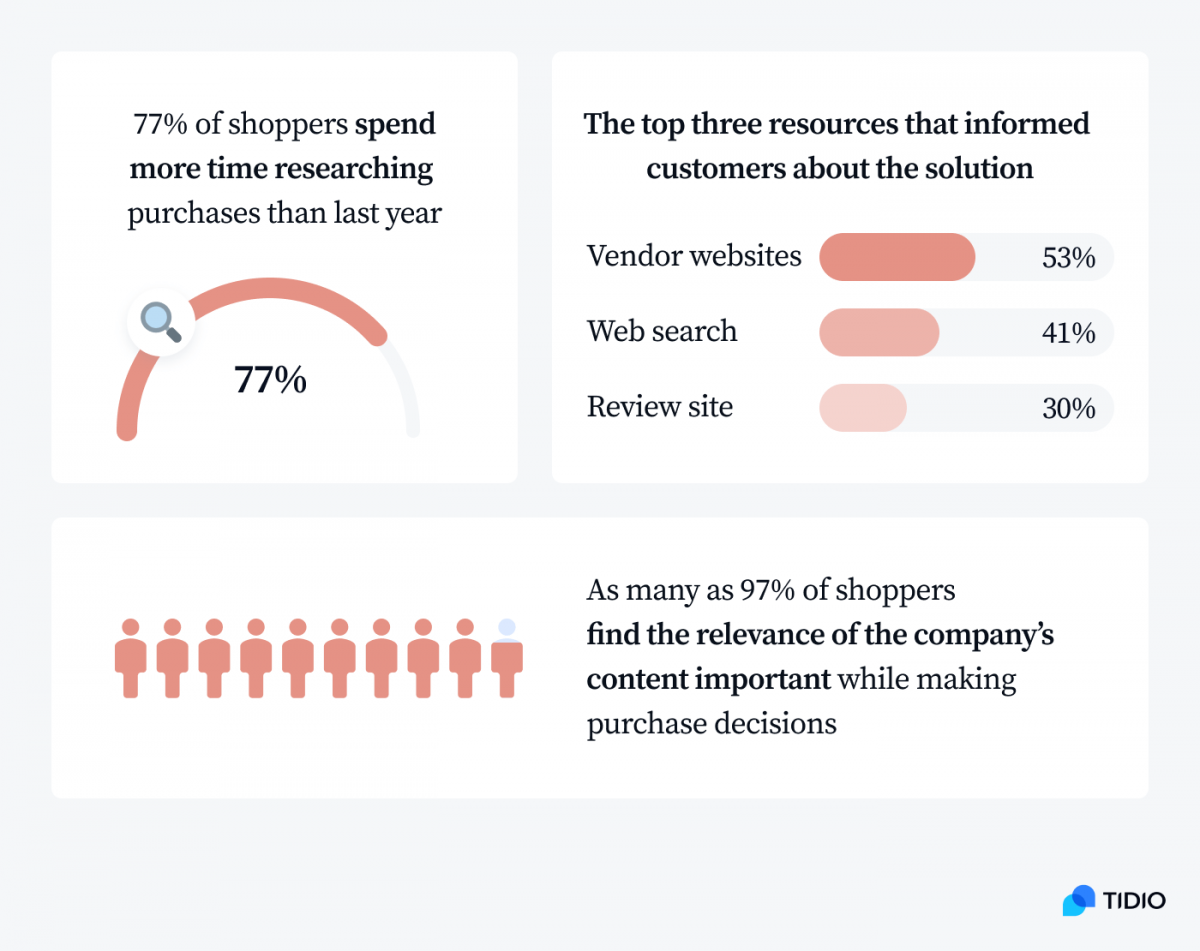
The 2020 B2B Buyer Behaviour Study by Demand Gen Report revealed that:
- About 77% of shoppers spend more time researching purchases than last year
- Web search (53%), vendor websites (41%), and review sites (30%) are the top three resources that informed them about the solution
- As many as 97% of shoppers find the relevance of the company’s content important while making purchase decisions
It means consumers are ready to spend a lot of time and resources to make informed decisions about what they buy. They find customer reviews trustworthy and judge the brands by the quality of content they present.
At Tidio, we see this trend, too. People won’t make a decision to sign up unless they’ve compared all the available options.
2. Convert visitors into inbound leads
After an anonymous, qualified prospect visits your website, you get a perfect chance to turn them into a lead (or sell your product straight away if you’re lucky). At this stage, you want nothing less than the visitor’s contact details—email address or phone number or some other way of reaching them. Once that happens, you’ve earned yourself an inbound lead. Congrats!
There’s a catch though—
You have to offer them something useful and valuable in exchange. It can be a(n):
- Ebook to download
- Free evaluation or a quote
- Free consultation
- Webinar ticket
The choice of the offer is specific to your type of business and the buyer persona you’re targeting. If it isn’t tailored to the needs of your target audience, it won’t work.
Pulling in new customers is usually more effective than acquiring them in a traditional, pushy way.
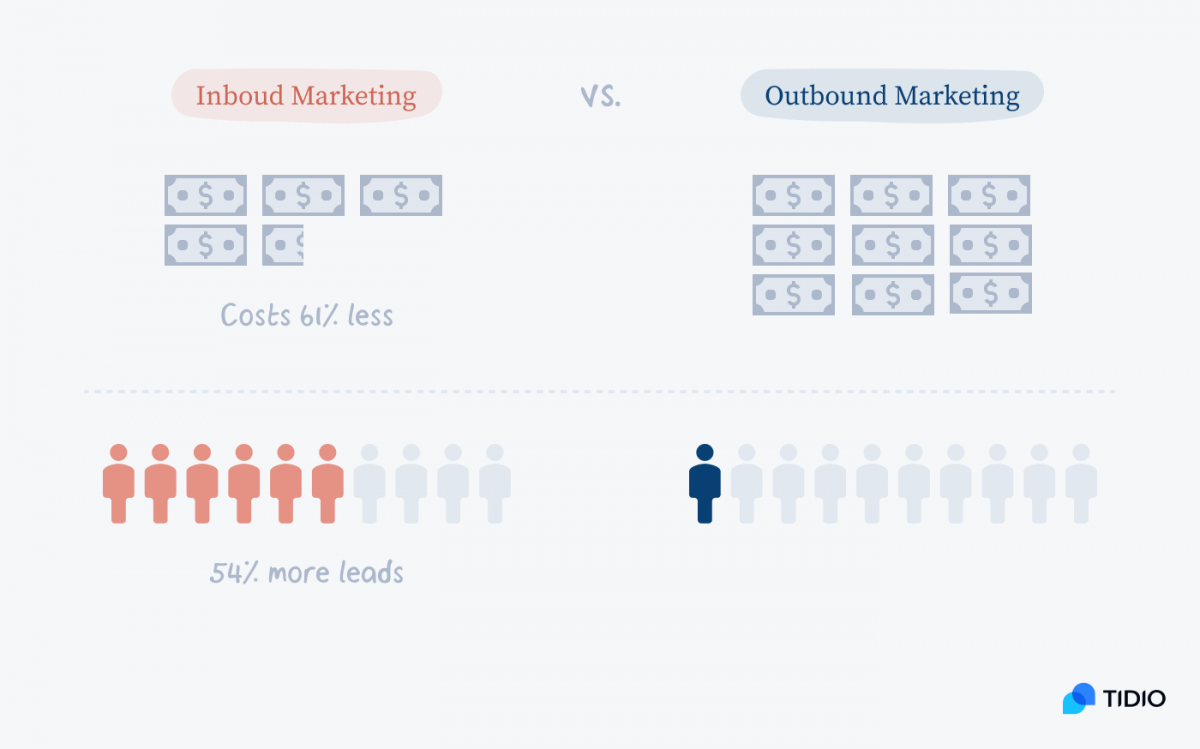
Why is inbound marketing so effective in lead generation?
The answer is simple. Intent marketing performs better because it’s targeting people who’ve already expressed interest in your products or services.
If a user searches for “best places to stay in Miami beach for families” their intent is crystal clear.
If you’re a family-friendly resort with a sea view AND capture their attention, the chances of them converting are much higher than if you cold-called some single guy who’s had no vacation in the last 3 years.
3. Close the deal
Righto. Now, seal the deal by turning new leads into paying customers.
The challenge here is the time. Yes, pull marketing generates better leads for less.
But when?
Well, the answer is neither precise nor optimistic. Neil Patel, whose blog generates over 2.5 million visits, said that it took him two years to start seeing noticeable results from content marketing.
Let’s just say that with inbound marketing it can take months or years to increase the deal flow.
But it’s worthwhile—
Once you create content, it doesn’t go away. Each new piece of content adds value to previous and future content you create. Unlike billboards when they come down, inbound campaigns ensure a constant flow of organic traffic.
And the process of attracting clients and delivering them to sales is seamless. The new leads are nurtured and then delivered to the sales CRM via marketing automation workflows, which makes the sales department work easier.
So to turn the most leads into customers, what you need most is a finely-tuned team.
Get inspired by Mike Volpe’s, ex VP of Marketing at HubSpot, recommendations about building teams by funnel stage as you grow.
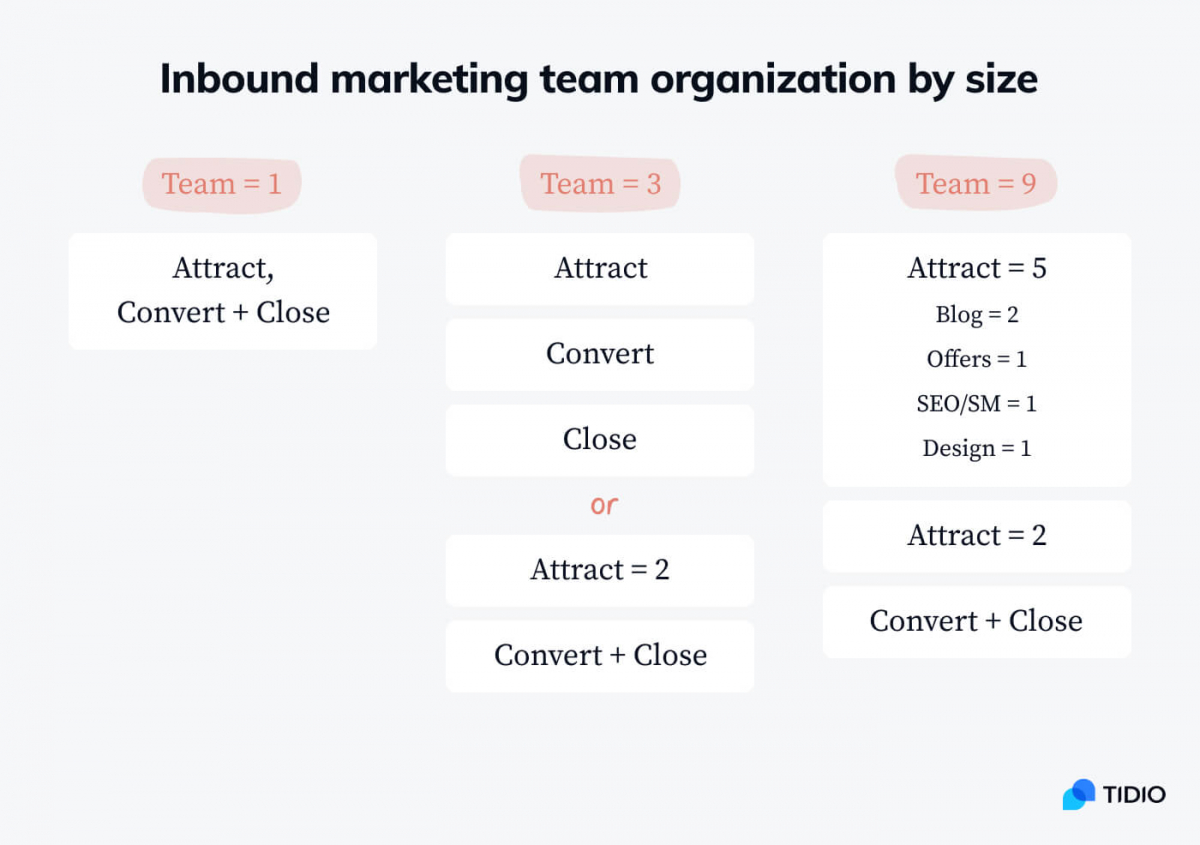
4. Delight customers so that they become your promoters
The last stage of inbound marketing methodology is to delight. Now, honestly, once you generate buyers, do you ever look back to see who they are? Do you try to create a long-lasting relationship with them?
If not, you’re losing money.
Pull marketing and friendship are similar. Here’s how:
We all know a guy whose stories seem to have no end. You walk into the office kitchen with “Hi, how are ya?” and then get stuck in a never-ending loop of their monologue. You regret wasting all your coffee break afterward.
You note to yourself to hang out more with people who actually listen to you, share your interests, and appreciate your opinions.
And that’s exactly what delighting customers is about.
When you make your customers feel special they will appreciate it and open up new distribution channels for you. Promote your brand to friends, family, or business partners.

How to build an effective inbound marketing strategy?
To build a solid inbound marketing strategy, you need to incorporate a set of tactics. The ideas below are actionable inbound practices that you can easily implement into your wider marketing plan.
1. Create a buyer persona and your target market
Creating a buyer persona is a prerequisite for a successful inbound marketing strategy.
Personas are semi-fictional characters who represent the company’s ideal customer. They share common characteristics, challenges, motivations and help you understand your potential customers. Personas are one of the best inbound marketing tools to guide you about the content your future customers are looking for throughout their conversion funnel.
By studying buyer personas, you can target the right prospects at the right time with relevant topics. To create an accurate picture of your buyer persona, consider:
- Demographics
- Income
- Location
- Needs and pain points
- Goals
- Daily activities
Research your customers’ journey, check their social networks.
Once your research is done, collect your data and visualize it. Here’s what you may end up with:
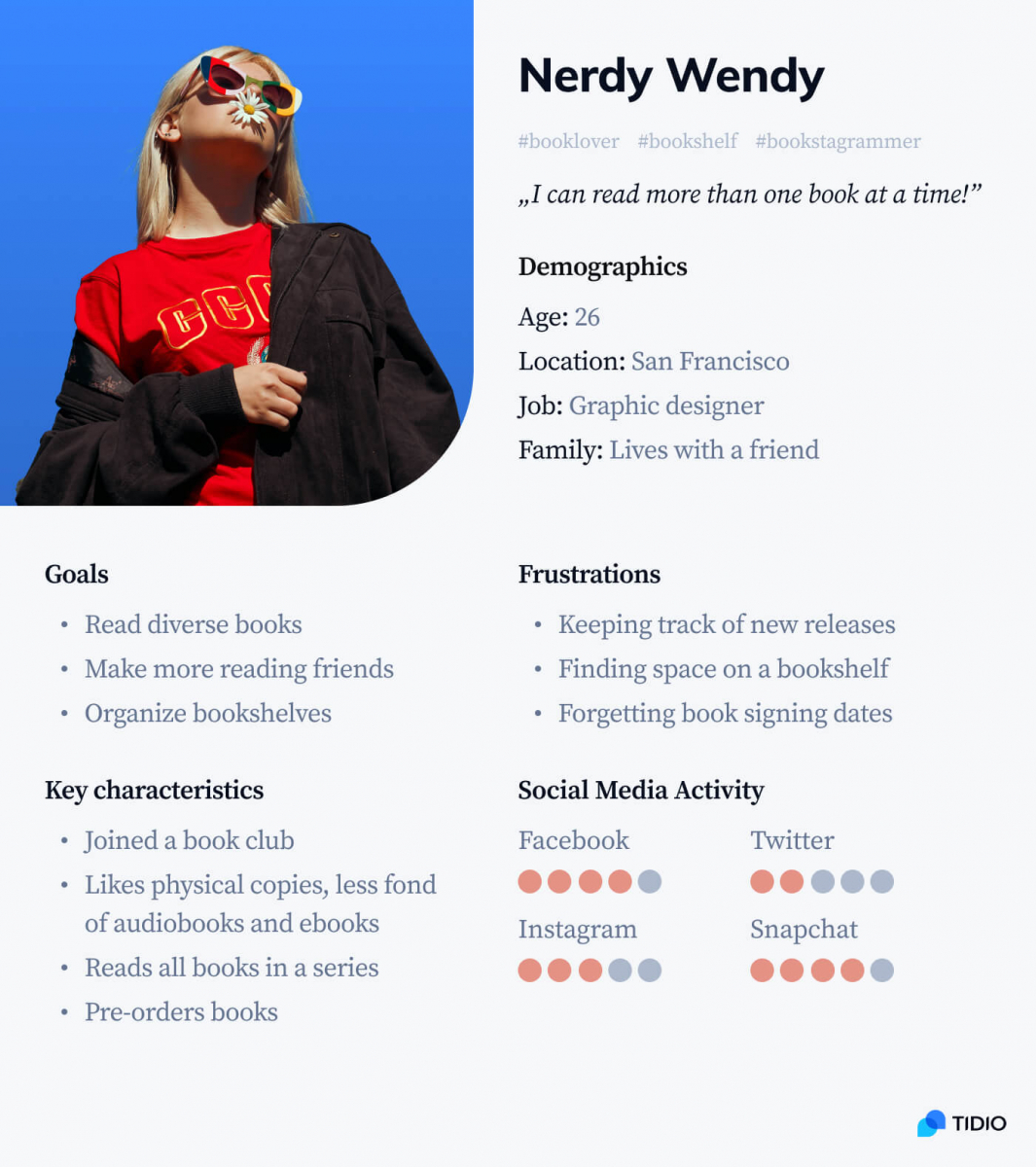
Free online resources to help you:
2. Create an effective content strategy
It’s more than just firing up a blog.
Consumers nowadays rarely feel the need to go to salespeople to tell them what to buy or what to believe. Instead, they research what they want without even speaking to a single human—not until they feel like it.
And at that point?
They are as informed as the seller himself.
That’s why non-commercial content attracts visitors to your website and makes them progress down the purchase funnel. Focus on solving the issues your potential customers have rather than products and services. That’s why blogging is the most popular choice for many companies to interest new customers in what they have to offer.
Free online resources to help you:
3. Adjust the type of content to stages of buyer’s journey
You can increase your visibility by producing various content formats that your potential customers find attractive or valuable during their buying process. The current trend is towards formats that are shorter and interactive and enable users to self-navigate through them.
According to the 2021 Demand Generation Benchmark Survey Report, the most popular content types are videos, white papers, and blogs, with webinars gaining more recognition.
Despite the general trend, buyers engage with different formats at different stages of their journey. Earlier in the journey, they are looking to get the information quickly. During mid-funnel, they prefer immersive formats that help them understand the topic. And in the final stages, they rely on peers and industry influencers. They turn to case studies, user reviews, and analyst reports.
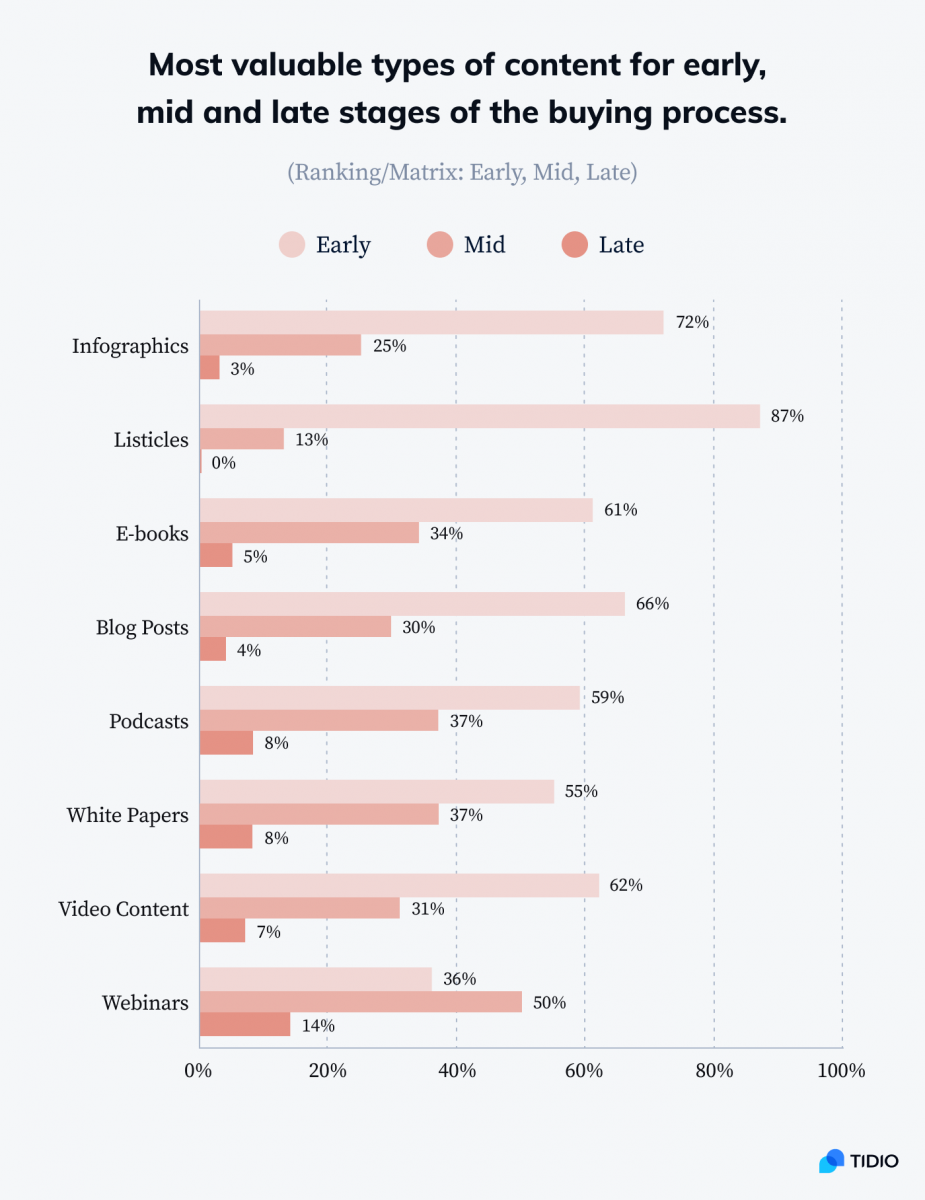
Free online resources to help you:
- Buyer’s journey four models
- How to create content for every funnel stage
- Content Examples for Every Stage
4. Create webinars to fill the live-event gap
A 2020 survey revealed that buyers value their personal data and time. They are most ready to supply information about themselves to access webinars. About 35% of customers spend 30-60
minutes consuming them and 33% spend 20-30 minutes.
In other words, webinars are very effective inbound marketing tools.
In the process of creating these engaging sessions, understanding how to launch a webinar effectively is key to capturing and maintaining the audience’s interest.
In comparison, 74% of respondents in the survey spend only up to 10 minutes with videos.
According to the survey, prospects don’t mind (or mind the least) revealing their email addresses, company names, their names, and job titles to register for webinars (51%).
Runner-ups are research/survey reports, white papers, and ebooks.
Free online resources to help you:
5. Start making memes
Yep, you read that right.
Your content should be educational, trustworthy, and all. But you can also have fun with it and use it to entertain your audience.
Meme marketing may be a bit unorthodox but is not just a fad. It’s becoming a very powerful tool in inbound methodology and can take your business to new heights. Memes are also easy to produce and cost close to nothing. If you make them relatable, they’ll resonate well with your audience, especially millennials and Gen Z.
Netflix mastered this unconventional marketing method to get fans engaged off-screen as well. Their most popular memes get up to 70,000 likes on Twitter and 500,000 on Instagram. The enviable result, isn’t it?
In the inbound marketing example below, Netflix links back to its original show and comments on the way people register multiple times under different names to use free trial periods. This post resulted in thousands of shares, which are a social media currency.
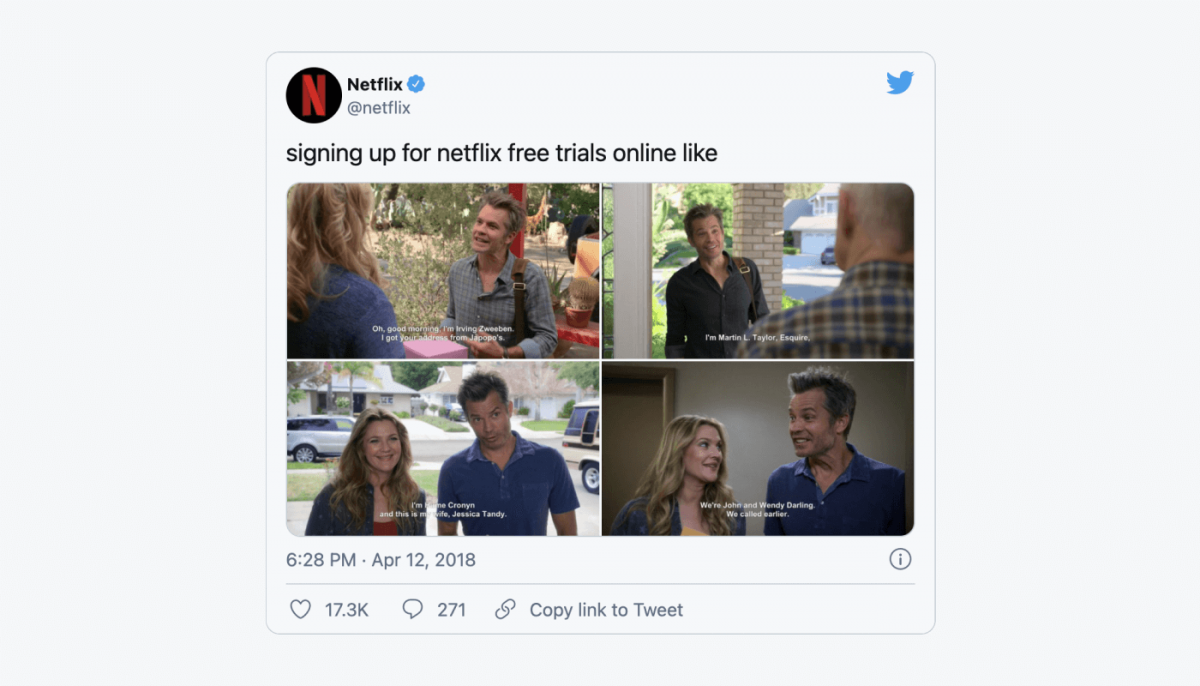
Free online resources to help you:
6. Use influencers on social media to your advantage
Potential customers don’t just look for information on Google. In fact, 43% of respondents in the 2020 Content Preferences Study said they prefer content from industry influencers. As many as 39% of respondents are influenced by peer content as well.
Influencer marketing is gaining more traction and investment because of its positive effect on ROI and growing popularity with customers. You can build relationships with influencers to promote your products or services, make positive brand associations, earn news coverage or even increase website traffic.
It would also be a shame if you didn’t share your great content on social media. It’s a great place to engage with new and existing audiences. It helps to increase your brand awareness.
Free online resources to help you:
7. Call visitors to action with CTA buttons
Call-to-action (CTA) elements compel users to take the desired action and are drivers for conversion—whether it’s downloading premium content or registering for a webinar. You can use CTAs across all channels.
Best practices include using actionable language and placing CTAs in a visible, concise, and relevant context to promote click-through rate. It’s also a highly visual asset, so align it with your branding and style for better results.
Below you’ll find a great inbound marketing example. We use informal ‘get’ that sounds more personal than ‘request’ and the word ‘free’ that highlights the value of our offer (and it really is free). By placing it in the middle of the page, we give users an immediate opportunity to convert.
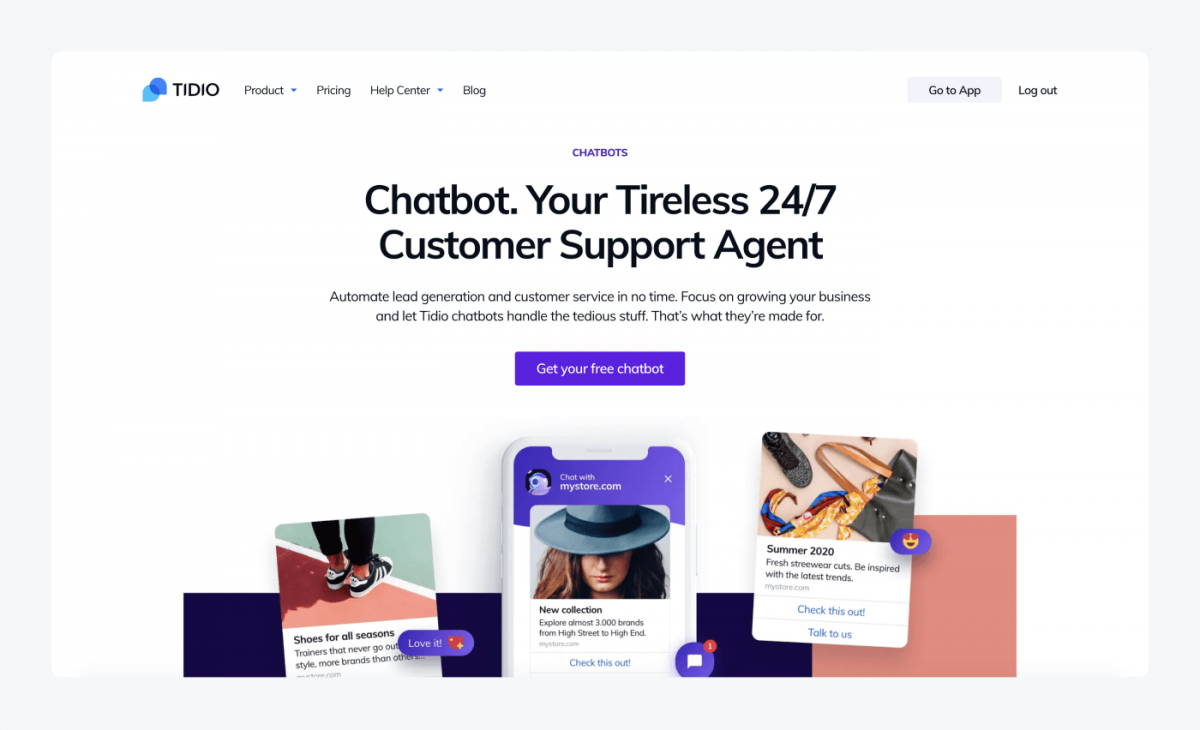
Free online resources to help you:
8. Build landing pages
Landing pages might be the most effective tool for inbound marketing.
They’re different from other pages on your website because they aim to persuade visitors to trade their contact info for your quality offer. Landing pages shouldn’t contain any other distractions. You can quickly learn how to build converting landing pages.
When a user ends up on a page with a form, sees a call to action, and decides to fill out the form with their personal information to get the offer—you’ve earned yourself a qualified lead. You can then store the provided information about your leads in a database and use it to close the sales cycle.
It’s a good idea to use marketing automation tools. They allow you to see what offers persuaded leads and how they’ve interacted with your site. The information you collect will enable you to nurture leads in a more targeted way and helps decide which marketing actions are best.
Free online resources to help you:
- Entertaining guide to landing pages
- Tips for creating a Facebook’s landing page
- Hubspot’s landing page builder
- Other landing page builders
9. A/B test your landing pages
One thing is to construct landing pages; it’s another thing to get it right.
To leverage them for maximum results, you need to test them.
A simple way to improve a landing page’s performance is to use A/B testing tools. They allow you to present different variations of the same offer to your audience and see which version is more appealing. A/B testing helps you improve the user experience and effectively generate leads.
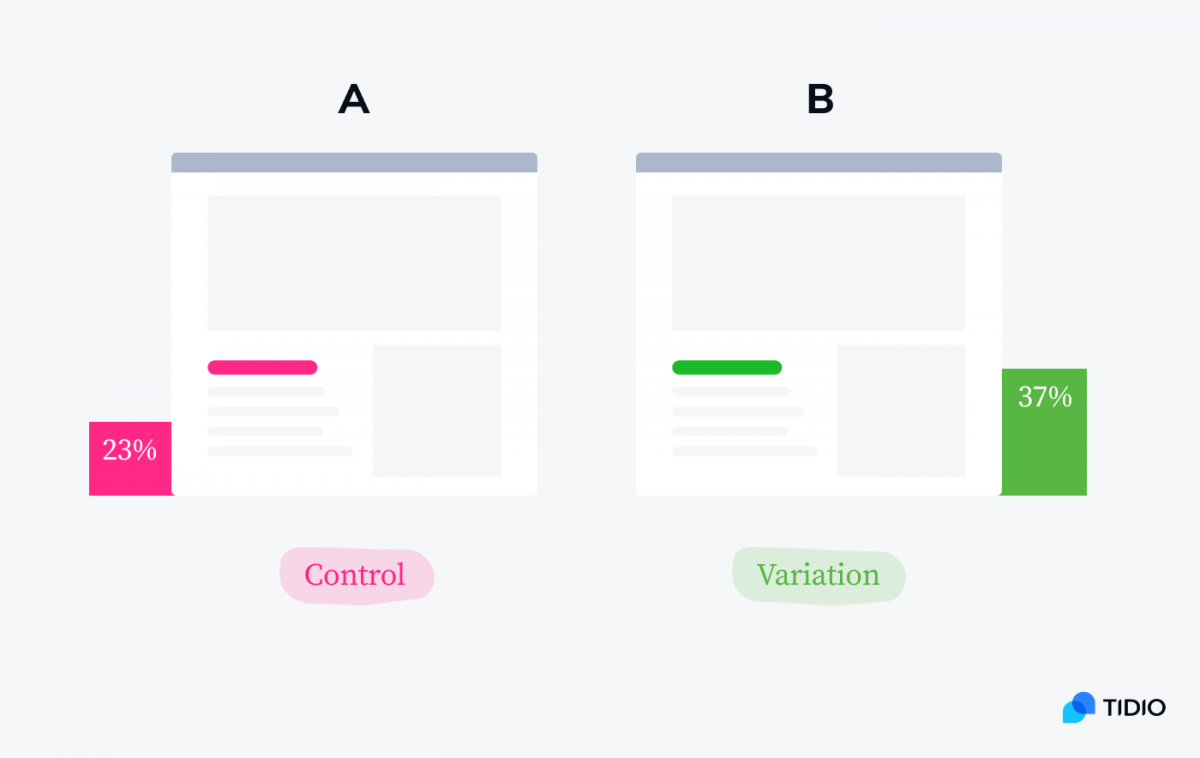
You can test as many elements of your page and compare the outcome. It helps make decisions based on quantifiable results. Sometimes a seemingly small choice can impact your conversions. For example, if you’re wondering if the word “FREE” is off-putting or encouraging your audience, the A/B test will give you the answer.
Free online resources to help you:
10. Optimize your pages for user intent
While it’s still essential to optimize pages for keywords, the most important rule is to write for humans first. Nowadays, Google focuses on understanding user intent and broader topics, not only target keywords. Google getting smarter means it is becoming a semantic search engine.
As a result, user behavior guides SERPs, and top-ranking pages answer users’ queries and provide the most value to them. If you want to nail your customers’ intent, do think of your ideal customer persona.
To find semantically related phrases for your topic, try typing your primary keyword into Google and see what it suggests, like in the example below. You can also use professional tools such as Ahrefs and SEMrush.
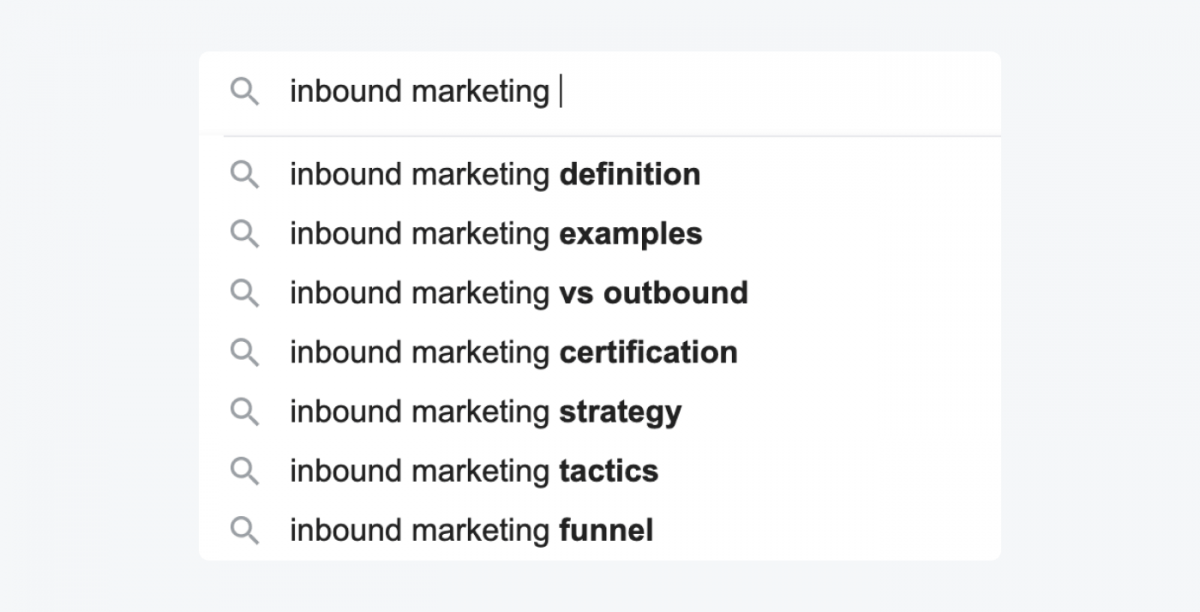
Free online resources to help you:
- Complete guide to search intent and SEO
- Quick guide to search intent
- Google’s post on searcher intent
11. Research your keywords
Although satisfying searcher intent improves your SERP ranking, keyword optimization still plays a significant role in showing bots what you’re trying to get across. Keyword research helps you increase your visibility as well as stay up-to-date with your users’ intent.

Remember that keywords’ quality is more important than their number. So organize them throughout the text naturally (without stuffing). Keyword research best practices include using your main keyword in your title tag, in the first paragraph, and your headings. Also, make sure to incorporate them in anchor text links and image alt-tags.
A good idea is to update existing blog posts with new keyword research for a quick and easy organic traffic boost.
Free online resources to help you:
12. Build high quality backlink profile
Backlinks (or inbound links) are other sites that link to your site. They can influence your ranking in SERPs. When another page links to your content, it signals to search engines that your content is trustworthy. The more “votes” from trusted pages, the better.
If you want other domains to link to your site, you need to create a “linkable asset,” that is, something worth linking to. One of our recent linkable assets is an article based on our original research that involved internet users recognizing content created by AI. We even got noticed by Vice.
Another way of increasing your backlink profile is to register with HARO as a source to answer reporters’ queries.
You can also outsource link building to an SEO company that will do all the heavy lifting for you, helping you gain more traffic and rank higher.
Free online resources to help you:
13. Try guest blogging
If you’re in the market for qualified traffic and quality backlinks, guest posting should be your go-to inbound marketing strategy. Remember to be smart about it and properly research blogs that you send your articles to. The aim isn’t to create a high volume of posts but to produce high-quality content on relevant topics on high-authority websites that your ideal customers actually read.
Google penalizes mass, mediocre guest blogging, so don’t fall into the trap of spam link building. Since the Penguin update, algorithms are getting better at detecting links designed for manipulating search engine results. The same goes for reciprocal linking.
Free online resources to help you:
- Guest blogging best practices
- How to integrate guest posts into you content strategy
- Guide to Google Penguin algorithm
14. Create effective email campaigns
Email campaigns motivate your target audience to visit your website if you follow email marketing best practices. Inbound email marketing focuses on sending emails to people already interested in your products, services, and brand. Otherwise, you’ll end up in a junk folder—every inbound marketer’s worst nightmare.
The addressees either willingly joined your subscription list or purchased with you before, so don’t undermine your prior work by sending them sloppy, spam emails. Send them in moderation and personalize them.
It can be tempting to reach as many people as possible. Still, it’s better to clean the email list regularly and contact only those who want to be contacted—as with all inbound marketing campaigns.
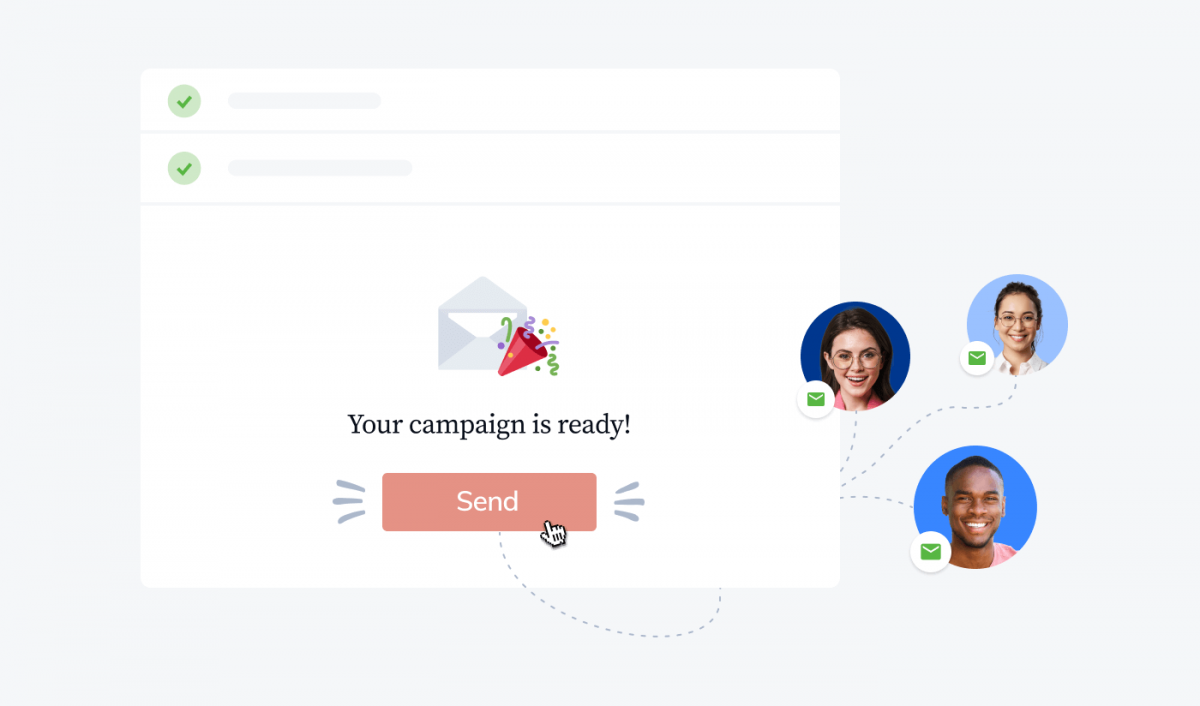
As your business grows, so does your mailing list. You can choose email marketing software to automate your email outreach efforts.
Free online resources to help you:
15. Test your headlines for CTR on a regular basis
The first thing that a user sees after typing in a keyword into the search bar is the headline. It’s really difficult to overstate its importance. It can increase user engagement and convince them to click, read or share your piece of content. Whether it’s a blog post, a Facebook post, a video, podcast, or a tweet. Remember, that often it’s the headline that is shared rather than the article itself.
In 2021, Buzzsumo analyzed 100 million article headlines in terms of their length and used phrases to see what makes a good one. It turns out that the most clickable headlines are instructional, arouse curiosity, and are time-centric.
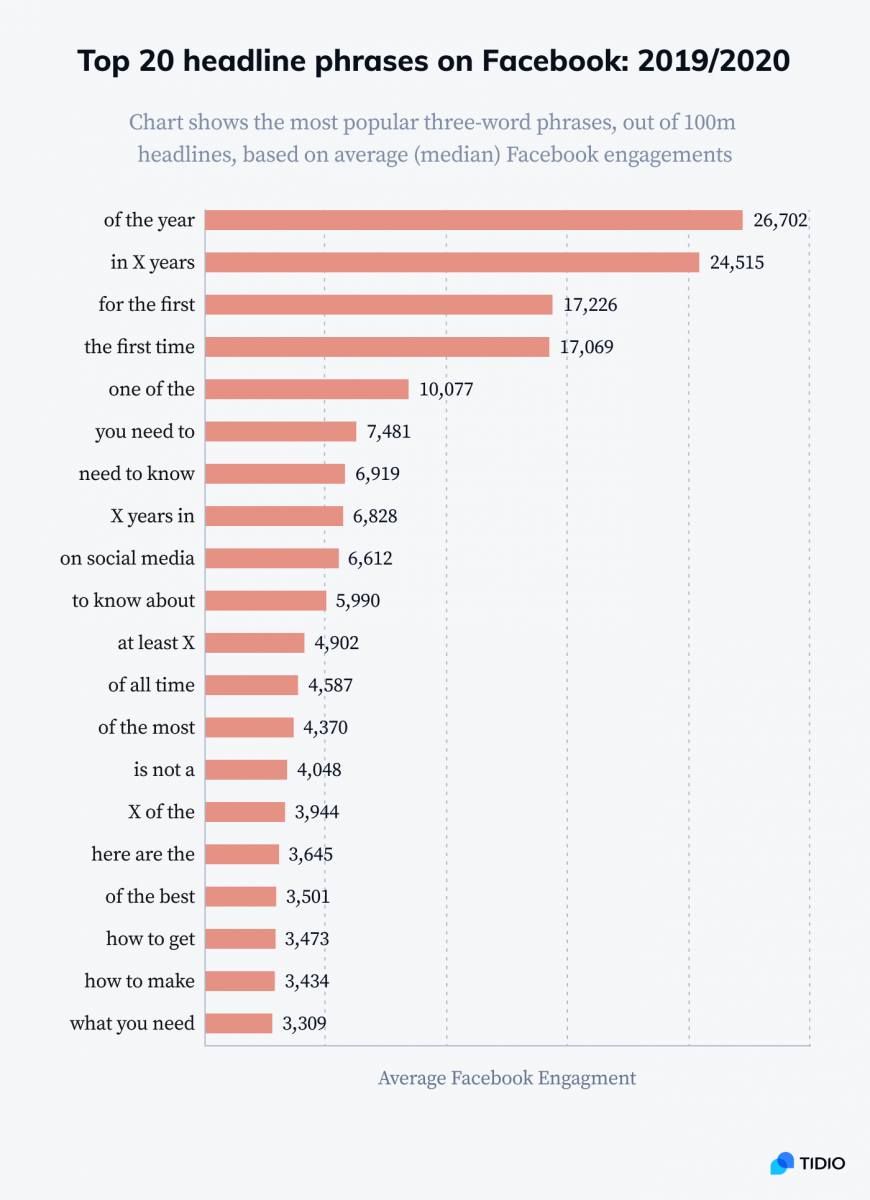
Free online resources to help you:
A quick wrap up
Here’s what to remember about inbound marketing:
- Inbound efforts aim to pull in customers who are already interested in what you offer
- In comparison with outbound, inbound strategies convert more leads for less
- Inbound activities can take longer to see results than outbound
- Inbound strategy capitalizes on people’s behavior online
*According to the National Transportation Safety Board Report and Marketing Agency Growth Raport.
Learn how to improve your inbound marketing using AI-assisted customer service

